Every person has at least one small or large birthmark on their body. Moles are pigmented formations usually brown or red in color. Normally, a mole does not pose any threat, but sometimes it can bring a lot of trouble to its owners. Pigment spots need to be constantly monitored. To do this, you will need knowledge about what types of birthmarks there are and where they come from. It is also useful to know how to remove a birthmark if it is causing you discomfort.

Birthmarks are common, but need to be monitored closely
What are birthmarks?
Moles and birthmarks on the body in medicine are collectively called nevus. They are similar in nature, but there is still a slight difference and the process of removing a birthmark differs from removing a mole. Birthmarks are inherited and are on the body from birth, and moles appear throughout life under the influence of various factors. Nevi are a collection of pigmented skin cells called melanocytes. The color of a birthmark is formed by the substance melanin. Depending on the pigment concentration, the spot may be brown, dark brown or even black.
Moles can be located in the superficial or deep layers of the skin. They look like spots or small rounded elevations on the surface of the body. The size of congenital birthmarks can range from several millimeters to ten centimeters. Moles most actively begin to appear during puberty. This is due to the increased secretion of melanotropic hormone from the pituitary gland, which stimulates the synthesis of melanin pigment. Nevus can occur on any area of the skin or mucous membrane.
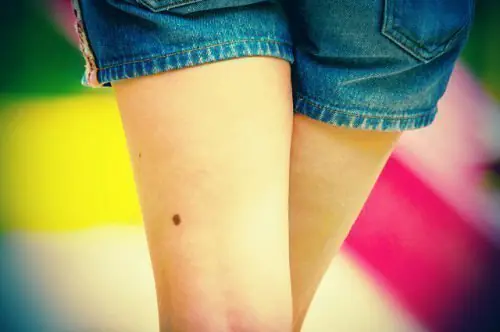
The majority of moles appear during adolescence
Variety of moles
Spots of different natures may appear on the skin at different periods of life; not all of them are actually nevi. The main types of birthmarks by origin:
Vascular spots include angioma. This is what science calls a red birthmark. Angioma occurs when capillaries grow rapidly or changes in the structure of skin vessels.
Moles, depending on the depth of their occurrence in the layers of the skin, are of three types:
- intradermal moles (accumulate deep in the dermis);
- superficial moles (located on the outer layer of the skin, in the epidermis);
- mixed moles (lying between two layers).
The color of mixed type nevi can be light brown or dark. Most often they are flat and have a size of up to ten millimeters. Superficial moles rise above the skin and may be covered with hair. The diameter sometimes reaches 1 cm. Moles that have an irregular shape or poorly defined borders are called dysplastic.
Non-trivial types of pigmentation include blue moles and Sutton's nevi. Sutton's nevi are moles surrounded by a white ring. Gradually, the amount of white skin increases and the pigment spot disappears. Disappearing moles and moles with a white ring have a high potential for degeneration into malignant tumors.
Blue moles have a smooth surface and are always hairless. Their border is clearly defined; blue moles can reach two centimeters in diameter.
Children in infancy and early preschool age often develop giant (up to 10 cm) moles. They are benign formations and are called hemangiomas.
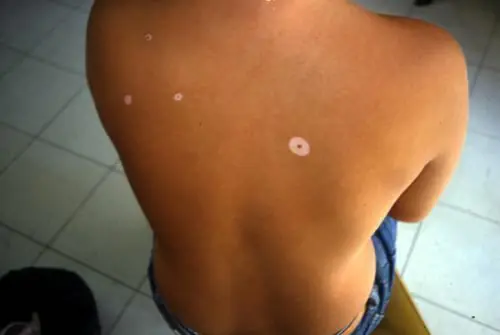
Sutton's nevus is a potentially dangerous formation
Why do birthmarks appear?
Pigment spots on the body appear under the influence of various factors. But the reason is always the same - increased secretion of melanin in the skin. Where do birthmarks come from?
- Genetic predisposition. Information about skin pigmentation is embedded in DNA and can be passed on from generation to generation.
- Long-lasting ultraviolet exposure. Ultraviolet rays from sunlight excite melanocytes and can cause moles to appear.
- Hormonal imbalance. A surge in the production of certain hormones can lead to increased melanin synthesis and the appearance of new moles.
- Viral infections, skin injuries, exposure to x-rays. These factors cause pigmented cells to move to the surface of the skin.
A vascular birthmark, in addition to the reasons listed, may appear due to diseases of the liver and pancreas. Red moles often appear in women during pregnancy. Such moles disappear within six months after the birth of the child.

Red moles often appear during pregnancy and disappear after it
Which nevi are dangerous?
Nevi are benign formations. Prolonged exposure to direct sunlight, trauma and infection of moles, hormonal changes can lead to the degeneration of cells into malignant ones. The degeneration of a mole can be noticed in the early stages if you regularly examine the skin. The danger begins in the following cases.
- The appearance of asymmetry of the birthmark.
- Change in spot color.
- Excessive growth of a mole.
- Violation of the boundaries of the birthmark.
- The appearance of lumpiness, peeling, cracking.
- Severe itching and bleeding from nevi.
- Disappearance of hair from the surface of the spot.
The listed transformations are signs of the onset of melanoma. This is the most severe skin disease of an oncological nature. There are other, less dangerous skin diseases associated with moles. One of these diseases is lentigo. Under certain conditions and improper treatment, lentigo can develop into melanoma.
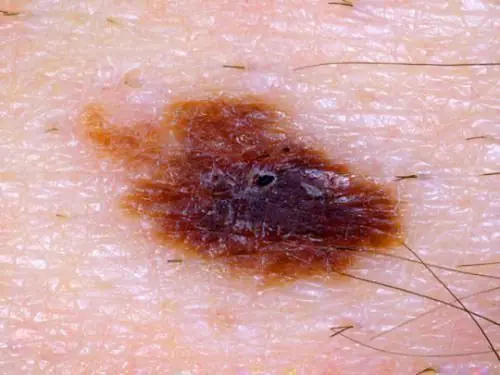
Asymmetry of the spot is an extremely alarming sign
Melanoma. Reasons for development
Melanoma is a malignant tumor that develops from melanocytes. This type of cancer often recurs. Melanoma can metastasize to almost all organs. If you notice the disease at an early stage and remove it in time, then there will be no consequences for the body. There are several signs that indicate the transformation of a mole into melanoma - ACORD melanoma.
- A – asymmetry. Diagnosis in modern clinics is carried out by a precise method of division into 12 axes of symmetry.
- K – edges. The edges of a pathological mole are uneven and jagged.
- O – coloring. The mole changes from brown to purple, red, etc.
- R – size. The normal size for a superficial mole is 6 mm.
- D – dynamics. Any active changes that occur with a mole - bleeding, itching, peeling, unexpected disappearance of a mole.
Sometimes melanoma is not colored, then it can be confused with a wart or papilloma. Some cancers are similar to varicose veins.
To fully diagnose melanoma, dermatoscopy and histological analysis are performed. The classic biopsy procedure cannot be performed; it involves trauma to the mole.
People at risk of developing melanoma include people with the following symptoms.
- Heredity. One of the relatives suffered from the disease.
- Skin hyperpigmentation. There are many moles on the body, they are all different sizes, there are blue nevi.
- Too white skin, blond hair and eyes.
- Age over 50 years.
- Xeroderma pigmentosum disease. Manifests itself in increased sensitivity to ultraviolet radiation. The disease is very rare.
Melanoma is a cancer with a high probability of recurrence, so the main risk group is patients who have previously had melanoma.

The removed birthmark is sent for histology
Lentigo. Main varieties
Lentigo appears in the form of small multiple pigment spots. They are located compactly. Lentigo resembles freckles. The color of the spots can be light or dark brown. There are several types of disease:
- solar lentigo;
- juvenile lentigo;
- senile lentigo.
The solar type develops on the face and forearm area. The reason for the development is sunlight and its long-lasting effect. The youthful type has nothing to do with the effects of ultraviolet radiation. It develops in adolescents mainly on the face due to hormonal changes. The development of lentigo in old age is associated with aging and changes in the skin. Pigmented rashes appear on the hands, on the back, and in the décolleté area.
In rare cases, lentigo can develop into melanoma, so the rash needs to be examined periodically.
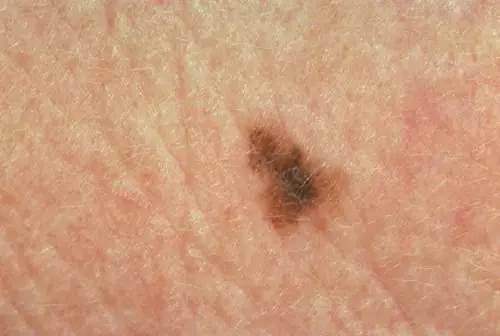
Lentigo in rare cases can develop into melanoma
Hemangioma in infants. Treatment methods
Hemangioma refers to vascular benign formations on the body. Hemangiomas develop in the initial months after birth, but are also possible in adulthood. The tumor can develop on the surface of the skin, on mucous membranes or in internal organs.
Children usually develop simple hemangioma. It appears on the surface of the skin as a clear spot. The spot usually rises above the skin and consists of several parts. Hemangioma is colored red or pink.
In children, hemangioma does not require treatment and goes away on its own by the age of five. You should consult a doctor if the tumor is actively growing.
The main causes of hemangioma include:
- heredity;
- vascular diseases;
- exposure to ultraviolet radiation.
A simple hemangioma does not pose a risk to the child’s health. Some unsightly spots on the face or prominent places can be removed using surgical methods or laser. Before removal, you need to consult a dermatologist, he will suggest a possible way to solve the problem.

Hemangioma in infants usually goes away on its own
Prevention of diseases associated with moles
To ensure that moles do not pose any danger, you must first eliminate the influence of harmful factors on the body. Moles can appear for various reasons.
- The first factor that has a serious impact on birthmarks is ultraviolet radiation. You can't stay in the sun for too long. It is best to sunbathe and sunbathe before noon, when the sun is less active. In the summer, you need to use protective creams. You should not visit the solarium too often.
- The second factor that can cause degeneration of education is hormonal levels. You cannot take hormonal medications on your own without consulting a doctor.
- The third factor is trauma to the growths. Birthmarks should not be scratched, torn off or handled with dirty hands. Particular attention should be paid to those moles that are located in places where they are constantly in contact with clothing. These are moles on the feet, on the waist and on the shoulders. It is better to remove birthmarks in these places. If the nevus is accidentally injured, you must immediately stop the bleeding using cotton wool and peroxide. Then a sterile dry gauze bandage is applied to the injury. If the growth is torn off, you need to wrap the piece in a bandage and take it to the clinic for histological analysis.
It is necessary to periodically carefully examine the skin and formations on it. Large spots without hair are best examined immediately by a dermatologist. A nevus that grows and changes color also needs to be examined. A dermatologist will identify the pathology and prescribe how to get rid of the birthmark.
Hair on moles should not be plucked or shaved; it is best to carefully trim them with small scissors.
Dermatologists are often faced with the question of whether it is possible to remove a birthmark from a child. Mole removal can be done at any age. Infants have nevi removed only as prescribed by a doctor.

Those with birthmarks should be extremely careful when tanning.
Modern methods of mole removal
If you have decided to get rid of a birthmark, then you need to pay attention to choosing a clinic or salon. Conditions in establishments must be sterile. The person who performs birthmark removal must be licensed or certified. Saving money and going to dubious cheap salons is dangerous. There they can get an infection that can cause a serious skin disease or allergy.
In clinics, moles are removed in the following ways.
- Laser evaporation (vaporization). There is nothing left of the pigment spot and it cannot be examined histologically. Therefore, it is better not to use this method. If these are red spots, they will be somewhat more difficult to remove.
- Laser cutting. In this case, tissue analysis can be performed, but a thermal burn remains on the skin.
- Removal by radio waves. This way you can remove spots on your face if they are small.
- Surgical removal of a mole with a scalpel. The most popular way to remove a birthmark.
Red vascular moles usually disappear on their own. If they are in a visible place, they can be removed with a laser.
Under no circumstances should you resort to the help of traditional healers to remove a mole or hemangioma.
Paying attention to even minor things like birthmarks can help you stay healthy. This does not require serious medical knowledge; just a few simple rules are enough.
Birthmarks (moles) are formations on the skin that many people do not pay attention to. And they are only interested in them if another mole is suddenly discovered on the body. What does the process of the emergence of new birthmarks indicate, and does it pose a health hazard?
What are birthmarks
Moles, or, as doctors say, nevi, are accumulations of special cells – melanocytes – in the layers of the skin. The purpose of melanocytes is to produce the pigment melanin, which protects the skin from harmful ultraviolet radiation. Normally, most melanocytes are located between the top layer of skin - the epidermis and the middle layer - the dermis. Melanocytes are usually distributed evenly over the surface of the skin. However, this does not always happen. Irregularities in the distribution of melanocytes lead to the formation of birthmarks.
Moles are usually dark or brown in color. Less commonly, almost black nevi can occur. Blue or purple moles are also observed.
Nevi are usually evenly colored, although on their surface there may be single darker and lighter areas compared to the background. A typical mole is round or oval in shape and has a diameter of no more than 5 mm. Moles larger than 10 mm are called giant. There are also birthmarks of irregular shape and uneven color - dysplastic nevi.
The most dangerous type of mole is a dysplastic nevus.
Nevi are also divided into intradermal and epidermal - depending on the depth of the accumulation of melanocytes.
Moles can be located on any part of the body. There are a lot of them on the arms, torso, and neck. However, most often (relative to the unit area) moles are found on the face. Moles can also form on mucous membranes, although this is rare.
Usually nevi do not protrude above the skin level. However, there are also protruding (convex) moles.
Lentigo and freckles
There is also a type of skin spots called lentigo. They are usually larger in size than a typical nevus, but also have a less intense, pale brown color and less clear boundaries. Their appearance is also associated with increased melanin production.
Another type of melanin-containing spots are freckles. Lentigines are most often observed in adults and the elderly, freckles - in children and adolescents. Lentigines and freckles are not usually classified as moles, although they have a similar origin.
Angiomas
Angiomas are also often classified as moles. These are red, slightly raised formations on the skin that are vascular in nature. If you press on such a formation, it will turn pale and then return to its original color. This is explained by the fact that angiomas consist of many tiny vessels. The mechanism of their occurrence is also not fully understood. Only one thing is clear - unlike ordinary moles, their occurrence is in no way connected with genetic reasons. Vascular moles have a relatively low risk of malignant transformation.
Angioma – vascular mole
When and who gets moles?
Although nevi are popularly called birthmarks, in fact, most moles are not present in a person from birth, but appear much later, throughout life. 99% of children are born with an absolutely clean body, devoid of age spots. And the first birthmarks appear in babies in the first or second year. However, these moles are so small that they are often simply not noticed.
Most moles appear on the body during adolescence and before the age of 25. This feature is associated with the intensive production of sex hormones during this period. And old moles may increase slightly or change color during puberty.
However, even in adults, age spots can occur from time to time. And some spots can also disappear spontaneously. The total number of moles can reach hundreds, although usually there are much fewer of them - no more than a dozen. There are also people who have almost no moles. Women usually have more birthmarks than men. Light-skinned people also have more moles than dark-skinned people.
Thus, the appearance of new moles in various parts of the body is a process that is a normal phenomenon in the body. Usually it is not associated with any pathologies. Of course, if the number of moles does not exceed a reasonable limit. And the birthmarks themselves look standard and do not cause discomfort.
Causes of birthmarks
The reason for the appearance of new birthmarks on the body is largely unclear. What is known is that the amount of melanin in the body is regulated by melanotropic hormone produced by the pituitary gland. Consequently, if a new mole appears on the body, this fact is often a consequence of increased levels of this hormone.
What phenomena affect the level of melanotropic hormone? First of all, such factors include an imbalance in the endocrine system. In women, this condition occurs during pregnancy and childbirth, in the period preceding menopause. Women are more likely to experience hormonal changes. Perhaps this circumstance is the reason for the more frequent appearance of birthmarks in women.
In men, this process can be triggered by diseases or injuries of the testicles, resulting in increased estrogen production. Also, the reasons for fluctuations in the level of melanotropic hormone can be:
- stress,
- serious illnesses,
- pathology of the pituitary gland,
- viral infections.
Insect bites and abrasions are another possible cause of moles. This circumstance is due to the fact that wounds can get infected, which often leads to local accumulation of melanin.
New moles can also appear after exposure of the skin to ultraviolet rays. Exposure to sunlight or other ultraviolet sources is accompanied by an increase in the level of melanin in the skin and the release of melanocytes to the surface. The sun's rays can not only lead to the appearance of new nevi, but also to the enlargement or degeneration of old ones. It is possible that other types of radiation, such as x-rays, contribute to the appearance of moles on various parts of the body. Such radiation can affect the body, for example, during medical procedures.
The causes of angiomas are dysfunction of the liver, intestines, and pancreas.
What to do if new birthmarks appear?
If one or two moles appear on the body in a place where there were none before, this is not yet a cause for concern. True, here you need to pay attention to the shape, color, size of the spot and accompanying symptoms. If the mole has the correct shape and uniform color, does not hurt, is not inflamed and does not bleed, then most likely it does not pose a danger. But a change in shape, color or increase in existing moles should be alarming.
If there are reasons for concern, or the nature of the formation is unclear, you should immediately consult a dermatologist. The fact is that some birthmarks can turn into malignant tumors - melanomas. The greatest danger is represented by dysplastic nevi. Although this happens infrequently, it still doesn’t hurt to be on the safe side. The main thing to remember is that you should not touch the mole or try to remove it yourself. This can lead to dire consequences.
Removal of common nevi is usually not indicated. The only exceptions are moles that protrude from the skin, the risk of injury to which is very high, moles that create psychological discomfort in the patient, as well as dysplastic nevi.
Why can there be many moles on the body, and are they dangerous?
The abundance of nevi in itself is not dangerous to health. However, they need to be closely monitored and regularly examined by a dermatologist. A doctor's examination is also required after a holiday in the southern resorts. Regular self-examination of the body is also necessary. If a new birthmark of an unusual shape appears on the body, or an old one has quickly grown and changed its shape, size and color, you should immediately consult a doctor.
Numerous moles on the body
People with an abundance of moles on their skin should remember that the sun is not only a friend, but also an enemy. The danger comes from the ultraviolet rays contained in the radiation of the star closest to us. When they come into contact with pigmented areas of the skin, they can cause their malignant degeneration. Therefore, it is necessary to limit the duration of sunbathing. In summer, you should not sunbathe during the most dangerous hours in the middle of the day, when the largest amount of hard UV rays reaches the Earth. And in a situation where the sun's rays fall on bare skin for a long time, it is necessary to use sunscreen to protect the body. Recently, there has been a thinning of the ozone layer in the atmosphere. This results in increased intensity of UV rays. It has also been established that people with pale skin are more susceptible to the negative effects of radiation than people with dark skin.
If a person has many nevi on his skin, then often only his genes can be to blame. It is known that the tendency to the abundant appearance of nevi can be inherited. Also, the appearance of moles is to some extent evidence of the biological processes of aging. Although, on the other hand, there is a theory that the abundance of moles reduces biological age by several years, and moles themselves are a protective factor for the body. According to popular belief, moles are a symbol of longevity and promote good luck. But another fact has been proven - the abundance of nevi increases the likelihood of developing skin cancer.
For what reason do birthmarks form, and whether they are dangerous - these questions will certainly arise for anyone who discovers such formations on their body or their child. And although birthmarks are not a rare occurrence, but occur in almost every person, few people know why they appear on the body and what factors contribute to this.
For the most part, moles do not pose a threat to life, but some can cause the development of cancer. Therefore, there is no need to be lenient about birthmarks on the body, but always carefully monitor their condition. Any obvious changes in their shape or size should alert everyone who has them on their body or the body of a child.
You need to be able to distinguish potentially “harmful” birthmarks from harmless moles in order to take timely measures to neutralize them. Of course, not everyone can determine without a specialist doctor which mole is a threat and which is not, so if you notice any changes in such spots on your body, contact a dermatologist without delay. He will tell you what to do and, if necessary, prescribe treatment.
How many moles can there be?
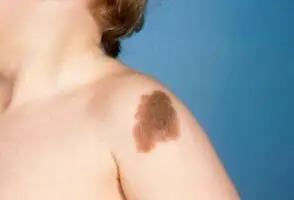
How many moles can a person have? This question is asked by many who, it seems to them, have too many of them on their body. It is impossible to answer this question with certainty - each person has a completely different number. By the way, freckles on the body, with which a person is simply covered, are also from the “family” of birthmarks. Usually, there are at least a dozen moles on a person’s skin, and no one has counted more.
This is interesting: moles have attracted close attention since ancient times. By the location of birthmarks, their size, and color shades, ancient predictors guessed what fate awaited the bearer of birthmarks.
Maybe such predictions will seem a little strange to some, but, in fact, there is nothing particularly strange or surprising about this. And now moles are used to “predict”, although not the distant future, but the present condition of the patient, his predisposition to any diseases or the presence of such. And it’s not “psychics” who do this, but doctors, based on scientific research.
Birthmarks. What is this
Many pigmented neoplasms on the skin are called birthmarks. Such spots are very diverse in many both external and structural characteristics. The size, shape, and color of all birthmarks may be different. Some are completely invisible, being hidden under the epidermis, while others, on the contrary, clearly rise above the skin. Some birthmarks are smooth and “bald”, while others grow hair.
Of the variety of birthmarks, only two of the most characteristic types are distinguished:
- the first type includes all types of age spots or nevi - the name comes from the Latin Naevulus;
- The second type includes the species diversity of vascular formations - angiomas.
According to an unwritten rule, people call a nevus a mole. Moles are nothing more than skin cells - melancites. Their permanent localization is the upper layer of the skin - the epidermis. Melancytes owe their name to the pigment that gives them the dark color characteristic of moles. This pigment is melanin. It is believed that nevi do not bypass any representative of the Caucasian race, although it is not specified how common they are in other races.
A characteristic feature of moles is that they are practically never congenital. As a rule, they can appear on the baby’s skin no earlier than at the age of two. The later date refers to the period when the child begins puberty, which is associated with hormonal changes occurring in the body. This distinguishes moles in general from birthmarks, which tend to form on the baby’s skin when he is born or a few months later.
As for vascular angiomas, scientists, in turn, propose dividing them into subtypes. There are basically two of them:
- The first subtype includes hemangioma - a neoplasm that develops in blood vessels and occupies the inner layer of the skin - the dermis. Hemangioma often has a congenital nature of formation, taking into account this factor, it is most correct to call hemangiomas “birthmarks”.
- The second type includes lymphangiomas. These cellular formations are formed with the participation of lymphatic vessels. In many cases, their formation occurs in the womb. But what is noteworthy does not appear immediately with the birth of a child, but only after two years to the third.
Reasons for appearance
Even taking into account the fact that nevi and angiomas have been studied quite well, researchers still have not scientifically and unequivocally answered the question of why birthmarks appear. At this stage of its development, medical science is not yet able to put together a holistic and uniform picture. At one time, most scientists agreed that the appearance of birthmarks is hereditary, that is, due to genetic factors.
And now this cannot be completely denied. At the same time, the overwhelming majority of birthmarks are not inherited. Still, there are certain factors that modern researchers use when linking the appearance of such formations, for example, in newborns:
- as a result of the occurring fluctuations in hormones in the body of a pregnant woman;
- various pathologies of the genitourinary system as a result of an infection;
- unfavorable external factors that have a negative impact on the pregnant woman’s body. Among such factors may be exposure to various radiations and toxic substances. As well as the negative influence of other factors, for example, as a result of sudden climate changes;
It was said a little earlier that traditional birthmarks in the form of hemangiomas also have differences. Of the vascular types of angiomas, the most widely represented are the following:
Strawberry. This type of hemangiomas has a red-berry color and a convex surface. The frequency of manifestations in newborns is not so high, in approximately 5 percent of babies born. True, it does not appear immediately, but after 20-30 days. Strawberry hemangioma does not have a specific location. It can appear on any area of the skin.
Cavernous. Or it is also called cavernous hemangioma. – Unlike strawberry hemangioma, it can have not only a red, but also a blue color. The shape is knotty and loose. But just like the first one, it is only capable of actively developing in the first two or three lives of a newborn. Then spontaneous drying occurs.
Capillary angiodysplasia. These are peculiar pigment spots of a flat shape. They may also have deep and superficial dilated capillaries. These pigment spots are also called “wine stains,” most likely because of their dark red and sometimes purple color. As they grow older, the spots can proportionally increase in volume and become more brightly colored. Localized in different places of the body. Quite often they “settle” on the skin of the head or face. In childhood, port-wine stains are hardly noticeable.
But this is not a complete list of all angiomas and nevi; at least, at least ten more types of them are known, which form during human life at different periods. But this should be discussed in another article.
It would also be a good idea to arm yourself with the knowledge you already have about what causes birthmarks to appear and what causes have a decisive influence on their appearance. And there are plenty of such reasons. To get at least a general picture, you should familiarize yourself with the list of some factors:
- One of the reasons for the appearance of birthmarks is inheritance with the genes of the parents. That is, it is inherited, and when parents have a large number of swarming spots on their skin, we can say with a greater degree of confidence that their children will also have a lot of them.
- Another equally common reason for the appearance of moles is hormonal pathologies associated with pregnancy. There is a peculiarity of their manifestation here. As a rule, moles appear during pregnancy and after pregnancy many go away spontaneously.
- Skin infection. This reason also occurs in a number of cases of birthmarks.
- Exposure to ultraviolet rays. Of course, when a person receives them in excess, for example, being in direct sunlight for a long time or when visiting a solarium. Try to avoid such exposure, especially if you have a lot of birthmarks on your body. Use special creams that will provide you with protection, but as for the solarium, it is better not to visit it.
Are birthmarks dangerous?
From a scientific point of view, all presented types and types of birthmarks are benign formations. That is, you can be sure that the vast majority of them do not pose any serious threat to our body. In addition, strawberry and cavernous hemangiomas that appear at an early age, for example, quietly leave the skin, disappearing without a trace by early school age.
But, as with all rules, there are also exceptions. This applies, for example, to “wine-wine” stains, which can remain on the body for almost a lifetime. However, it is possible to shorten the period of their stay on the body artificially - with the help of modern medical methods.
However, the risk that benign spots will develop into malignant tumors exists, even though the percentage of such a risk is only one in half a million. In most cases, this occurs as pigmented nevi (moles), which can develop into a malignant tumor - melanoma.
If this happens, then the main thing in this situation is to diagnose the disease in a timely manner and take all necessary measures for cure. Malignant formations of this type can be cured almost one hundred percent, but only in the early stages of the disease. Therefore, at the slightest suspicion of cancer, consult a doctor immediately.
Conclusion
Scientists have been arguing for a long time about why moles and other pigmented formations on the skin appear, but there is no definite answer yet. However, medicine has stepped far forward in this matter; it knows a lot about the nature of birthmarks and how to protect the patient from the degeneration of benign birthmarks into dangerous diseases.
In this regard, there is no need to be afraid if you see birthmarks on your body. People live with them until they die. And not everyone wants to get rid of them. After all, sometimes a birthmark simply decorates a person and makes him unique.
They just need to be monitored to prevent complications.



